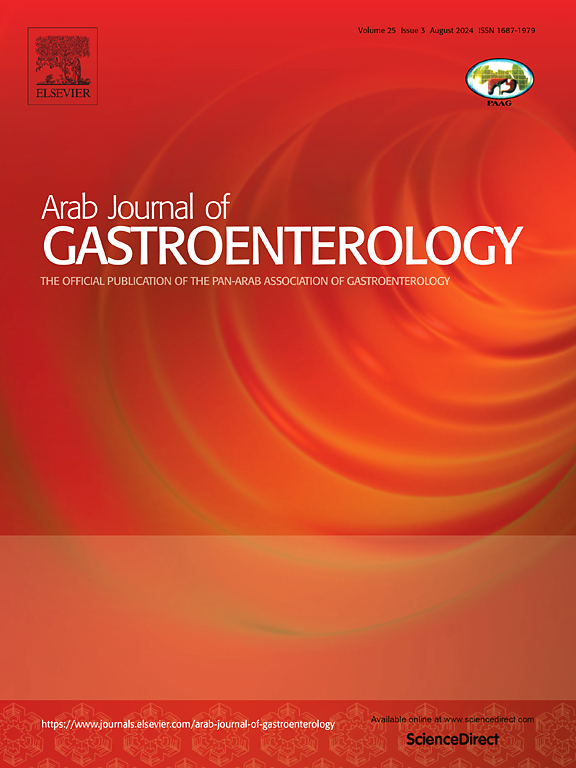Changes in liver stiffness and non-invasive markers in chronic hepatitis C virus patients with and without HIV co-infection following interferon-free antiviral treatment
IF 1.1
4区 医学
Q4 GASTROENTEROLOGY & HEPATOLOGY
引用次数: 0
Abstract
Background and study aims
HIV alone can induce liver fibrosis whereas co-infection with HCV presents a significant challenge in hastening the development of chronic liver disorders such a liver fibrosis, cirrhosis, and hepatic malignancy. Information on the influence of HIV on liver stiffness (LS) after treatment with direct-acting antiviral (DAAs) agents is scarce. The aim of this study was to assess the changes in LS using transient elastography (TE) and fibrosis scores (Fibrosis-4 [FIB-4] and AST-to-platelet ratio index [APRI]) before the initiation of treatment and six months after the end of treatment (EOT) with DAAs in HCV/HIV co-infected patients compared with HCV mono-infected patients.
Patients and methods
All consecutive chronic HCV patients treated with DAAs during 2016–2020 were retrospectively recruited. TE was performed at baseline and SVR24. Fibrosis scores such as FIB-4 and APRI were calculated in parallel. Improvement of liver fibrosis was defined as any changes in the fibrosis category at baseline to a lower fibrosis category at SVR24.
Results
Of 288 HCV-infected patients, 217 (75.3 %) were HCV mono-infected and 71 (24.7 %) were HCV/HIV co-infected. A significant decrease in TE values was noted at SVR24 compared with baseline (10.3 kPa vs. 7.9 kPa, respectively; P= <0.0001 in HCV mono-infection; 5.9 kPa vs. 5.3 kPa, respectively; P= <0.0001 in HCV/HIV co-infection). Moreover, the proportion of HCV mono-infected patients who had stable, improvement, and worsening in fibrosis stage at follow-up was 50.2 %, 43.3 %, and 6.5 %, respectively while it was 54.9 %, 32.4 %, and 12.7 %, respectively in HCV/HIV co-infection. In multivariable analysis, the higher fibrosis category was the only factor that influenced the improvement of liver fibrosis at follow-up, whereas HIV co-infection wasn’t confirmed.
Conclusion
patients with HCV mono-infection and HCV/HIV co-infection experienced a rapid and significant improvement in LS and fibrosis indices. This improvement was more pronounced in those with high fibrosis grades at baseline.
无干扰素抗病毒治疗后伴有和不伴有HIV合并感染的慢性丙型肝炎患者肝脏硬度和非侵入性标志物的变化
背景和研究目的:HIV单独可以诱导肝纤维化,而HCV合并感染在加速慢性肝脏疾病(如肝纤维化、肝硬化和肝恶性肿瘤)的发展方面提出了重大挑战。直接作用抗病毒药物(DAAs)治疗后HIV对肝硬度(LS)影响的信息很少。本研究的目的是利用瞬时弹性成像(TE)和纤维化评分(纤维化-4 [FIB-4]和ast -血小板比值指数[APRI])评估HCV/HIV合并感染患者在开始治疗前和治疗结束后6个月(EOT)与HCV单一感染患者相比的LS变化。患者和方法:回顾性招募2016-2020年期间所有连续接受DAAs治疗的慢性HCV患者。TE分别在基线和SVR24进行。同时计算FIB-4和APRI等纤维化评分。肝纤维化的改善被定义为从基线纤维化类别到SVR24较低纤维化类别的任何变化。结果:288例HCV感染者中,单纯HCV感染者217例(75.3%),合并HCV感染者71例(24.7%)。与基线相比,SVR24的TE值显著降低(分别为10.3 kPa和7.9 kPa;P=结论:HCV单感染和HCV/HIV合并感染患者的LS和纤维化指标改善迅速且显著。这种改善在基线时高纤维化等级的患者中更为明显。
本文章由计算机程序翻译,如有差异,请以英文原文为准。
求助全文
约1分钟内获得全文
求助全文
来源期刊

Arab Journal of Gastroenterology
Medicine-Gastroenterology
CiteScore
2.70
自引率
0.00%
发文量
52
期刊介绍:
Arab Journal of Gastroenterology (AJG) publishes different studies related to the digestive system. It aims to be the foremost scientific peer reviewed journal encompassing diverse studies related to the digestive system and its disorders, and serving the Pan-Arab and wider community working on gastrointestinal disorders.
 求助内容:
求助内容: 应助结果提醒方式:
应助结果提醒方式:


